Cycling the Rhondda Fach valley
Aberdare to Cardiff via Maerdy (36 miles)
The Welsh valleys are littered with old railway cycling paths, a legacy of the coal mining industry. Unfortunately, most of these routes end at the top of a valley, so unless you’re willing to ride up and back, it’s a problem getting to the terminus of some of the valley cycle paths. We are going to cycle down the Rhondda Fach Valley starting at Maerdy, though the nearest train station is in the Cynon Valley at Aberdare. Three of us stepped down from the train on a chilly overcast day and without delay we were off. Since we’re officially starting at Aberdare, it’s only appropriate we give the town a mention.
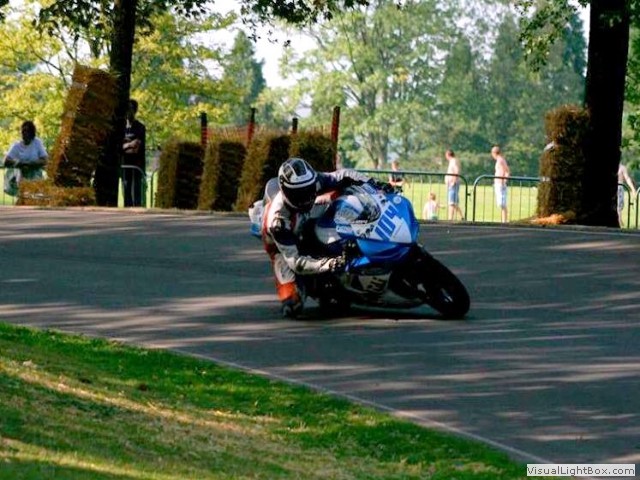 Aberdare sits on the confluence of the river’s ‘Dare’ and ‘Cynon’, its growth
began like many Welsh valley towns; first with iron, then coal, but it’s also famous for the ‘Thomas &
Williams Safety Lamp’ which was made at the Cambrian Lampworks, but for me the fondest
memories are from ‘Aberdare Park’. I have ridden in cycle races around this park which is
less than a mile long, but the most fascinating detail is; it’s used for motorcycle
racing too. It’s only a few meters wide, there’s no safety fences, no run off gravel, and during race days
they put hay bales against the trees, but it really is a public park which normally
accommodates mothers pushing prams feet away from the track!
Aberdare sits on the confluence of the river’s ‘Dare’ and ‘Cynon’, its growth
began like many Welsh valley towns; first with iron, then coal, but it’s also famous for the ‘Thomas &
Williams Safety Lamp’ which was made at the Cambrian Lampworks, but for me the fondest
memories are from ‘Aberdare Park’. I have ridden in cycle races around this park which is
less than a mile long, but the most fascinating detail is; it’s used for motorcycle
racing too. It’s only a few meters wide, there’s no safety fences, no run off gravel, and during race days
they put hay bales against the trees, but it really is a public park which normally
accommodates mothers pushing prams feet away from the track!
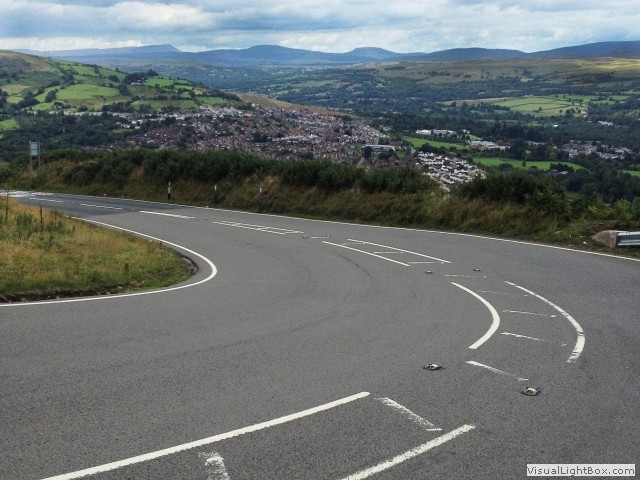 We rode past the 160 year market building and left the town to cycle up the Cefnrhos-gwawr (Aberdare
Mountain), winding around
several hairpin bends, climbing a 16% gradient to the top (a tough climb even for the
Pro’s). Near the summit, we divert off the road onto a rough surfaced forest track. It's then downhill
to meet up with the nice tarmac cycle path past the ‘Castell Nos reservoir’ named after
the medieval castle that once overlooked the Valley. Then we follow the ‘Cwm
Rhonda-Fach’ river on a dedicated cycle path (NCR881) on the course of the old ‘Taff Vale
railway’. We pass what was the site of Maerdy Colliery spoil heaps, the crenulated slag tips are
clearly still visible covered in moss except for the black water gullies. Much
of the countryside around here was used as an industrial tipping ground, with no thought for
the future. Great efforts have been made in the past decades to erase the scars left by
the Industrialists of the 18th and 19th Centuries. Over a hundred years ago, there were 53
collieries in the Rhondda, by 1990, Maerdy was
the only one left, but by 1992 its colliery buildings were razed to the ground and nothing
remains of Maerdy colliery today
We rode past the 160 year market building and left the town to cycle up the Cefnrhos-gwawr (Aberdare
Mountain), winding around
several hairpin bends, climbing a 16% gradient to the top (a tough climb even for the
Pro’s). Near the summit, we divert off the road onto a rough surfaced forest track. It's then downhill
to meet up with the nice tarmac cycle path past the ‘Castell Nos reservoir’ named after
the medieval castle that once overlooked the Valley. Then we follow the ‘Cwm
Rhonda-Fach’ river on a dedicated cycle path (NCR881) on the course of the old ‘Taff Vale
railway’. We pass what was the site of Maerdy Colliery spoil heaps, the crenulated slag tips are
clearly still visible covered in moss except for the black water gullies. Much
of the countryside around here was used as an industrial tipping ground, with no thought for
the future. Great efforts have been made in the past decades to erase the scars left by
the Industrialists of the 18th and 19th Centuries. Over a hundred years ago, there were 53
collieries in the Rhondda, by 1990, Maerdy was
the only one left, but by 1992 its colliery buildings were razed to the ground and nothing
remains of Maerdy colliery today
As we drop down into station road Maerdy past the old colliery tragedy memorial, a great
black and dark green cliff looms over the town reflecting its sombre past, with a marked absence of trees, giving
the impression of a rather sterile landscape. From Maerdy the cycle path is in the process of being
restored, currently its surface is almost
un-ridable on teeth rattling hardcore. We continue on through Blaenllechau/ Ferndale where three or four rows of stone
terraced houses cling to the mountainside such is the steepness of the topography. We pass under Ferndale
bridge, the village used to have a large station here, though passenger services were withdrawn in 1964. From
here it’s along the Rhondda Fach River on the temporary hardcore path, until we cross the river on a small
footbridge, now the path is ridable again. There’s a series of small waterfalls with pools, two
weeks ago I think we would piled into the river to cool down, but today it's too cold so we plough on.
The next village is Pontygwaith where we jump onto 'Furnace road' named after a blast furnace
here, built in the early 16th century. It's not until 'Wattstown' where we ride back on the
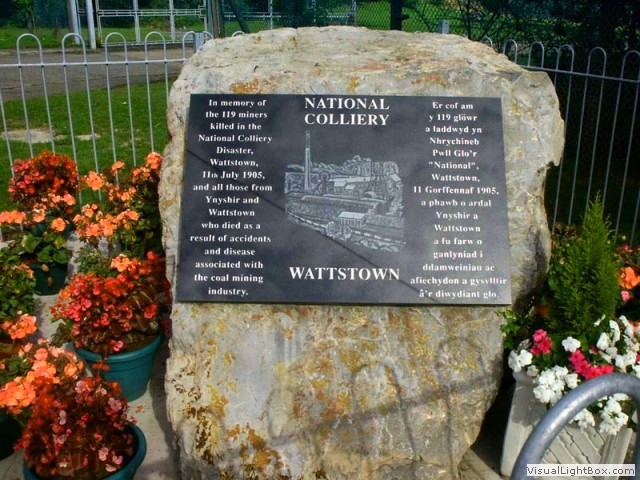 NCR881 and just up to the left of us (where 'Peacocks store' is now), was the 'National Colliery'. The mine
suffered two mining disasters in 1887 and 1905 with a total loss of 9 and 119 men and
boys respectively. We ride through Ynyshir which holds the testimony of the first
colliery to be opened in the Rhondda Fach valley, and onto Porth; regarded as the gateway
to the Rhondda, because both the Rhondda Fawr and Rhondda Fach valleys converge here.
NCR881 and just up to the left of us (where 'Peacocks store' is now), was the 'National Colliery'. The mine
suffered two mining disasters in 1887 and 1905 with a total loss of 9 and 119 men and
boys respectively. We ride through Ynyshir which holds the testimony of the first
colliery to be opened in the Rhondda Fach valley, and onto Porth; regarded as the gateway
to the Rhondda, because both the Rhondda Fawr and Rhondda Fach valleys converge here.
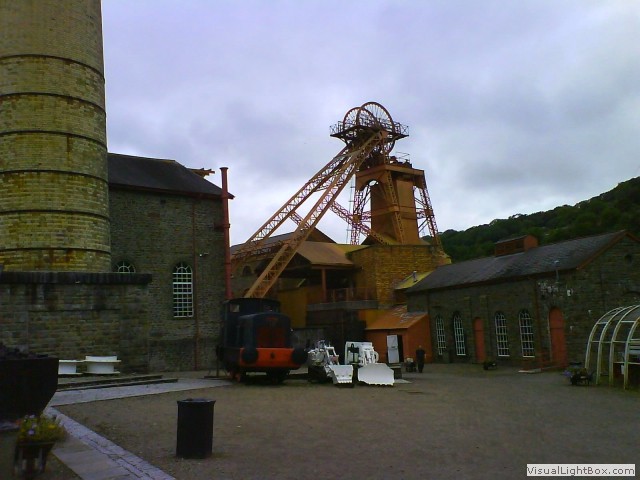 We travel past the inconspicuous sealed pit shafts of the old Hafod mine and under
the mainline railway and backtrack slightly to Rhondda Heritage
Park. Rhondda Heritage Park is situated on the former Lewis Merthyr Colliery, once
a thriving coal mine now preserved as a tourist attraction. You enter the museum
through Victorian period shops, where we had a coffee and met ‘Graham’, an ex miner now
our tour guide. He was a font of knowledge and gave a great insight into the tough
life miners had to endure. The highlight of the tour was the underground jaunt, a
simulated walk of the underground mine with some unexpected moments (if I told you
about them it would spoil the tour). After the tour around
the park we follow an old tramway route on the south side of the Rhondda River
heading east to ‘Barry sidings’. Barry Dock & Railway Company’s railway line
terminated here (over twenty miles from Barry). Today there is an extensive
park and visitor center at ‘Barry sidings’ which comes highly recommended by 'Tripadvisor™'. Without
leaving Barry sidings car park, we cross the Rhondda river to visit ‘Hetty
Pit colliery winding house’, the building contains the original steam engine
built by Barker & Cope of Kidsgrove in 1875, today it’s powered by
compressed air. There’s also the pit headgear wheel still standing and a listed
footbridge leading to Hopkinstown, which allowed the miners walk to the colliery. We head
back over the Rhondda River and continue on the Barry Dock & Railway Company’s
line to Pontypridd, riding along, you could be mistaken for thinking you're in the middle
of a huge forest, such is the view.
We travel past the inconspicuous sealed pit shafts of the old Hafod mine and under
the mainline railway and backtrack slightly to Rhondda Heritage
Park. Rhondda Heritage Park is situated on the former Lewis Merthyr Colliery, once
a thriving coal mine now preserved as a tourist attraction. You enter the museum
through Victorian period shops, where we had a coffee and met ‘Graham’, an ex miner now
our tour guide. He was a font of knowledge and gave a great insight into the tough
life miners had to endure. The highlight of the tour was the underground jaunt, a
simulated walk of the underground mine with some unexpected moments (if I told you
about them it would spoil the tour). After the tour around
the park we follow an old tramway route on the south side of the Rhondda River
heading east to ‘Barry sidings’. Barry Dock & Railway Company’s railway line
terminated here (over twenty miles from Barry). Today there is an extensive
park and visitor center at ‘Barry sidings’ which comes highly recommended by 'Tripadvisor™'. Without
leaving Barry sidings car park, we cross the Rhondda river to visit ‘Hetty
Pit colliery winding house’, the building contains the original steam engine
built by Barker & Cope of Kidsgrove in 1875, today it’s powered by
compressed air. There’s also the pit headgear wheel still standing and a listed
footbridge leading to Hopkinstown, which allowed the miners walk to the colliery. We head
back over the Rhondda River and continue on the Barry Dock & Railway Company’s
line to Pontypridd, riding along, you could be mistaken for thinking you're in the middle
of a huge forest, such is the view.
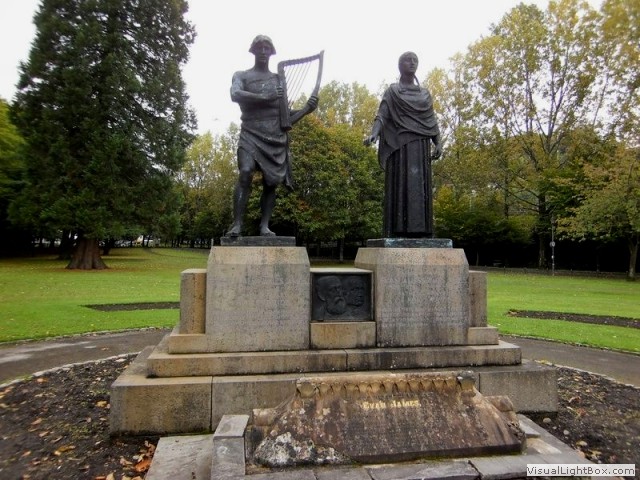 It's a must to visit Ynysangharad War Memorial Park at Pontypridd which
holds the National Lido of Wales; the Lido Ponty. The 1920's 'Art Deco' Lido now boasts modern
facilities including three heated outdoor swimming pools and a great café.
It’s now onto the old Alexandra Dock Railway path, which is part of the ‘Taff
Trail’ passing the ‘University of South Wales, Pontypridd Campus’ and then through
Rhydyfelin. We're on the Celtic Trail (East) now which sits on the side of the valley over one hundred and sixty
feet above the River Taff, but you wouldn’t know it as the route becomes tree lined restricting views. When we
reached Nantgarw it was worth a small diversion to ‘Nantgarw China Works Museum’. We
turned west on the old Nantgarw road crossing over the busy Cardiff to Merthyr road
It's a must to visit Ynysangharad War Memorial Park at Pontypridd which
holds the National Lido of Wales; the Lido Ponty. The 1920's 'Art Deco' Lido now boasts modern
facilities including three heated outdoor swimming pools and a great café.
It’s now onto the old Alexandra Dock Railway path, which is part of the ‘Taff
Trail’ passing the ‘University of South Wales, Pontypridd Campus’ and then through
Rhydyfelin. We're on the Celtic Trail (East) now which sits on the side of the valley over one hundred and sixty
feet above the River Taff, but you wouldn’t know it as the route becomes tree lined restricting views. When we
reached Nantgarw it was worth a small diversion to ‘Nantgarw China Works Museum’. We
turned west on the old Nantgarw road crossing over the busy Cardiff to Merthyr road
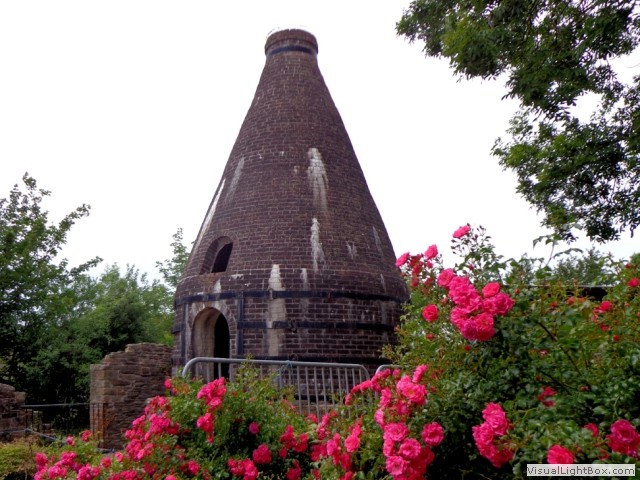 (A470) on a pedestrian bridge and arrived at the free museum. It was established
in 1813 by two former employees from the Royal Worcester factory, who set up on the
banks of the Glamorganshire canal (click the image to see more). From here we closely follow the River Taff on the
old 'Cardiff Railway Company' line built on the east side the river, through 'Taff's
Well' and then it’s a pleasant freewheel through Tongwynlais to 'Plan2ride' bike shop/café
for a brew. Now refreshed we travel under the mighty Coryton interchange
roundabout (don’t ride on the road, it’s too dangerous) eventually we pop out onto the
Glamorganshire canal. Then back onto the ‘Taff Trail’ following the River Taff at
Llandaff. We’ve written about the route from here to Cardiff on another ride, click
here to read about it.
(A470) on a pedestrian bridge and arrived at the free museum. It was established
in 1813 by two former employees from the Royal Worcester factory, who set up on the
banks of the Glamorganshire canal (click the image to see more). From here we closely follow the River Taff on the
old 'Cardiff Railway Company' line built on the east side the river, through 'Taff's
Well' and then it’s a pleasant freewheel through Tongwynlais to 'Plan2ride' bike shop/café
for a brew. Now refreshed we travel under the mighty Coryton interchange
roundabout (don’t ride on the road, it’s too dangerous) eventually we pop out onto the
Glamorganshire canal. Then back onto the ‘Taff Trail’ following the River Taff at
Llandaff. We’ve written about the route from here to Cardiff on another ride, click
here to read about it.
There were many little remnants of the long forgotten collieries along the route, but the highlight of the trip had to be the ‘Rhondda Heritage Park’, which confirmed my theories about how viable the coal mines were before they were forced to shut. I’ve said before ‘this isn’t a political blog’, but since we’ve been riding on our little trips starting in 2013, time after time we've exposed the 1980’s as a period of massive industrial decline. Steel, coal, railways, and ship building industries (the list is not exhaustive) established over centuries vanished through ill conceived prophesies or arrogant political agendas. All I can say is; ‘something very wrong, even immoral, and astigmatic happened to British industry during this decade’. Sadly, Britain will never be able to reincarnate its industrial past, future politicians must study this era and realise poor decisions made now, can span subsequent generations and some wounds will never heal.
-
Gallery
 Why not have a look at the gallery relating to this ride. Click the image or the title.
Why not have a look at the gallery relating to this ride. Click the image or the title. -
Kangchenjuga from Darjeeling
 Without anyone realising how valuable it was; an original Edward Lear painting hung on
the Aberdare library stairs for 26 years. Painted in 1879 it was eventually bought by the
National Museum of Wales in 2006 for £300,000.
Without anyone realising how valuable it was; an original Edward Lear painting hung on
the Aberdare library stairs for 26 years. Painted in 1879 it was eventually bought by the
National Museum of Wales in 2006 for £300,000. -
Maerdy disaster
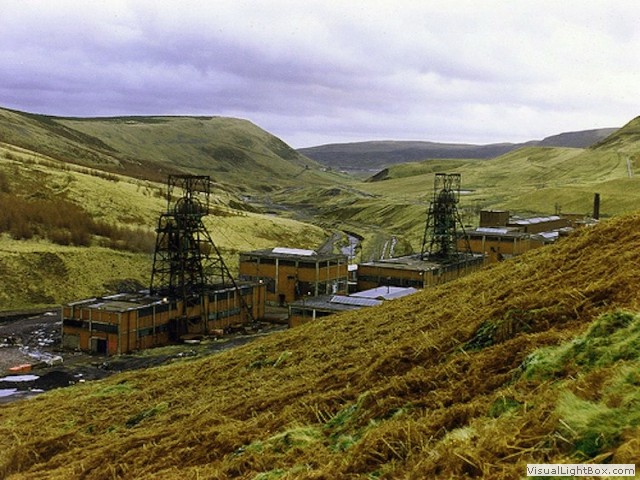 At 14.40 on Christmas Eve in 1885, an underground explosion ripped through Maerdy
colliery killing 81 men and boys. At the time there was no phones or even a telegraph at Maerdy, so a horse mounted
runner was sent to Pontypridd to raise the alarm. One hour and twenty minutes later the
runner reached Pontypridd and broke the horrific news. Most of the bodies
were recovered early Christmas Day. Although no single cause was identified, the coroner criticised
safety procedures, including how coal dust was allowed to build up.
At 14.40 on Christmas Eve in 1885, an underground explosion ripped through Maerdy
colliery killing 81 men and boys. At the time there was no phones or even a telegraph at Maerdy, so a horse mounted
runner was sent to Pontypridd to raise the alarm. One hour and twenty minutes later the
runner reached Pontypridd and broke the horrific news. Most of the bodies
were recovered early Christmas Day. Although no single cause was identified, the coroner criticised
safety procedures, including how coal dust was allowed to build up. -
The Corona Pop factory
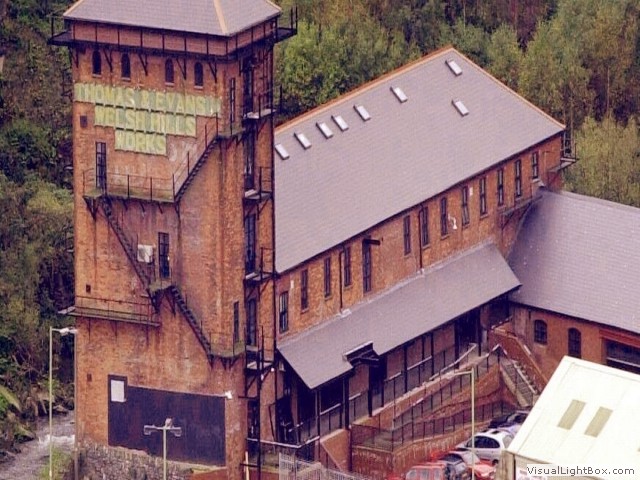 The Corona story all began with a small factory in Porth at the foot of the Rhondda
valleys. The firm had its origins tied to the temperance movement which was gaining momentum in Britain during
the late 19th century. Grocers, William Evans and William Thomas pioneered a non-alcoholic ginger beer
in an effort to to keep the miners sober (drunkenness was a big issue at the time), the
venture failed, but Corona did become successful producing quirky carbonated soft drinks like
dandelion and burdock.
The Corona story all began with a small factory in Porth at the foot of the Rhondda
valleys. The firm had its origins tied to the temperance movement which was gaining momentum in Britain during
the late 19th century. Grocers, William Evans and William Thomas pioneered a non-alcoholic ginger beer
in an effort to to keep the miners sober (drunkenness was a big issue at the time), the
venture failed, but Corona did become successful producing quirky carbonated soft drinks like
dandelion and burdock. -
Barry sidings
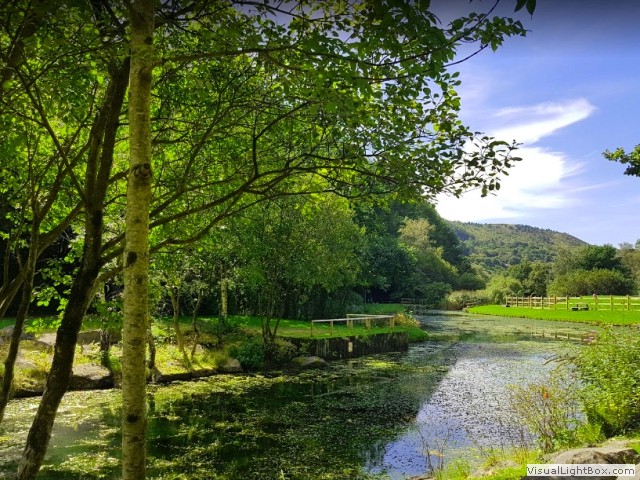 Barry sidings formation arose out of frustration among the Rhondda coal mine owners
who had to put up with the expensive tolls at Cardiff Docks and the transportation
monopoly the ‘Taff Vale Railway’ held north of the river. There was also
congestion at Cardiff docks because all the South Wales collieries offloaded
there. In 1883 a group of Rhondda mine owners, formed themselves into a cabal and sought permission
to build a new dock at Barry, serviced by a new railway, within a few years the dock
and the new railway were built, now there was an alternative route and a choice of
docks to export Welsh coal to the World. There’s nothing obvious that a massive transport
hub existed here, it’s now a pretty park.
Barry sidings formation arose out of frustration among the Rhondda coal mine owners
who had to put up with the expensive tolls at Cardiff Docks and the transportation
monopoly the ‘Taff Vale Railway’ held north of the river. There was also
congestion at Cardiff docks because all the South Wales collieries offloaded
there. In 1883 a group of Rhondda mine owners, formed themselves into a cabal and sought permission
to build a new dock at Barry, serviced by a new railway, within a few years the dock
and the new railway were built, now there was an alternative route and a choice of
docks to export Welsh coal to the World. There’s nothing obvious that a massive transport
hub existed here, it’s now a pretty park. -
The National Lido of Wales
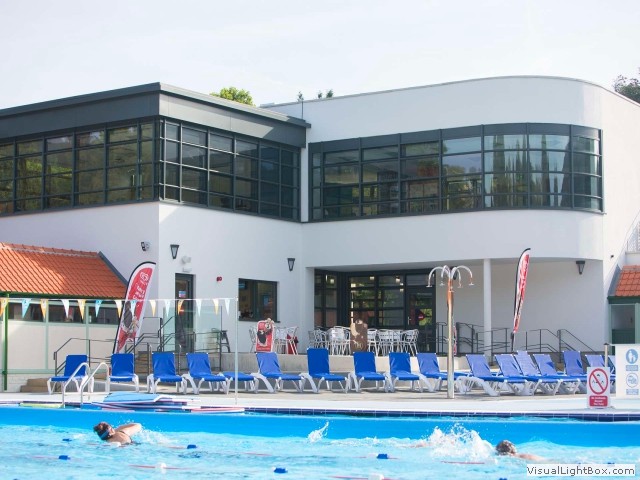 ‘Lido Ponty’ is a unique survivor of the network of open-air swimming pools that once existed
all across Wales. Surprisingly (considering how contaminated it must have been), the local river
even supplied the water for the pool, but not today. During the refurbishment they
managed to retain the original outdoor changing boxes and turnstiles, dating back to 1927. The
art-deco features of a 1934-35 extension have also been refurbished. The Lido's most
famous swimmer was Jenny James, she trained here and was the first Welsh person to swim the English channel.
‘Lido Ponty’ is a unique survivor of the network of open-air swimming pools that once existed
all across Wales. Surprisingly (considering how contaminated it must have been), the local river
even supplied the water for the pool, but not today. During the refurbishment they
managed to retain the original outdoor changing boxes and turnstiles, dating back to 1927. The
art-deco features of a 1934-35 extension have also been refurbished. The Lido's most
famous swimmer was Jenny James, she trained here and was the first Welsh person to swim the English channel. -
The Glamorganshire canal
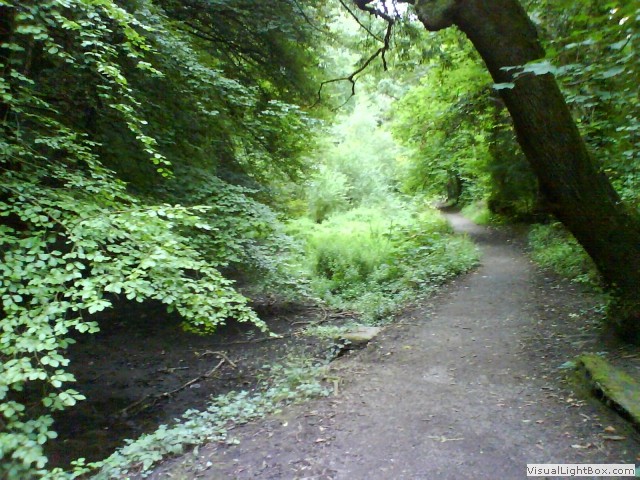 Richard Crawshay owned the 'Merthyr Iron works' and had the Glamorganshire canal
built to transport iron from Merthyr to Cardiff by using 'trows', it was completed in
1794. The trows could hold up to five tons of iron, and were about sixty feet long and nine feet wide. Little remains
of the the 25 mile long canal today, so it was a treat to ride along one of the
last remaining stretches of this 200 year old canal into cardiff, though the experience was slightly
tainted by the canal being very smelly.
Richard Crawshay owned the 'Merthyr Iron works' and had the Glamorganshire canal
built to transport iron from Merthyr to Cardiff by using 'trows', it was completed in
1794. The trows could hold up to five tons of iron, and were about sixty feet long and nine feet wide. Little remains
of the the 25 mile long canal today, so it was a treat to ride along one of the
last remaining stretches of this 200 year old canal into cardiff, though the experience was slightly
tainted by the canal being very smelly.

 Without anyone realising how valuable it was; an original Edward Lear painting hung on
the Aberdare library stairs for 26 years. Painted in 1879 it was eventually bought by the
National Museum of Wales in 2006 for £300,000.
Without anyone realising how valuable it was; an original Edward Lear painting hung on
the Aberdare library stairs for 26 years. Painted in 1879 it was eventually bought by the
National Museum of Wales in 2006 for £300,000. 
 The Corona story all began with a small factory in Porth at the foot of the Rhondda
valleys. The firm had its origins tied to the temperance movement which was gaining momentum in Britain during
the late 19th century. Grocers, William Evans and William Thomas pioneered a non-alcoholic ginger beer
in an effort to to keep the miners sober (drunkenness was a big issue at the time), the
venture failed, but Corona did become successful producing quirky carbonated soft drinks like
dandelion and burdock.
The Corona story all began with a small factory in Porth at the foot of the Rhondda
valleys. The firm had its origins tied to the temperance movement which was gaining momentum in Britain during
the late 19th century. Grocers, William Evans and William Thomas pioneered a non-alcoholic ginger beer
in an effort to to keep the miners sober (drunkenness was a big issue at the time), the
venture failed, but Corona did become successful producing quirky carbonated soft drinks like
dandelion and burdock. Barry sidings formation arose out of frustration among the Rhondda coal mine owners
who had to put up with the expensive tolls at Cardiff Docks and the transportation
monopoly the ‘Taff Vale Railway’ held north of the river. There was also
congestion at Cardiff docks because all the South Wales collieries offloaded
there. In 1883 a group of Rhondda mine owners, formed themselves into a cabal and sought permission
to build a new dock at Barry, serviced by a new railway, within a few years the dock
and the new railway were built, now there was an alternative route and a choice of
docks to export Welsh coal to the World. There’s nothing obvious that a massive transport
hub existed here, it’s now a pretty park.
Barry sidings formation arose out of frustration among the Rhondda coal mine owners
who had to put up with the expensive tolls at Cardiff Docks and the transportation
monopoly the ‘Taff Vale Railway’ held north of the river. There was also
congestion at Cardiff docks because all the South Wales collieries offloaded
there. In 1883 a group of Rhondda mine owners, formed themselves into a cabal and sought permission
to build a new dock at Barry, serviced by a new railway, within a few years the dock
and the new railway were built, now there was an alternative route and a choice of
docks to export Welsh coal to the World. There’s nothing obvious that a massive transport
hub existed here, it’s now a pretty park.  ‘Lido Ponty’ is a unique survivor of the network of open-air swimming pools that once existed
all across Wales. Surprisingly (considering how contaminated it must have been), the local river
even supplied the water for the pool, but not today. During the refurbishment they
managed to retain the original outdoor changing boxes and turnstiles, dating back to 1927. The
art-deco features of a 1934-35 extension have also been refurbished. The Lido's most
famous swimmer was Jenny James, she trained here and was the first Welsh person to swim the English channel.
‘Lido Ponty’ is a unique survivor of the network of open-air swimming pools that once existed
all across Wales. Surprisingly (considering how contaminated it must have been), the local river
even supplied the water for the pool, but not today. During the refurbishment they
managed to retain the original outdoor changing boxes and turnstiles, dating back to 1927. The
art-deco features of a 1934-35 extension have also been refurbished. The Lido's most
famous swimmer was Jenny James, she trained here and was the first Welsh person to swim the English channel. Richard Crawshay owned the 'Merthyr Iron works' and had the Glamorganshire canal
built to transport iron from Merthyr to Cardiff by using 'trows', it was completed in
1794. The trows could hold up to five tons of iron, and were about sixty feet long and nine feet wide. Little remains
of the the 25 mile long canal today, so it was a treat to ride along one of the
last remaining stretches of this 200 year old canal into cardiff, though the experience was slightly
tainted by the canal being very smelly.
Richard Crawshay owned the 'Merthyr Iron works' and had the Glamorganshire canal
built to transport iron from Merthyr to Cardiff by using 'trows', it was completed in
1794. The trows could hold up to five tons of iron, and were about sixty feet long and nine feet wide. Little remains
of the the 25 mile long canal today, so it was a treat to ride along one of the
last remaining stretches of this 200 year old canal into cardiff, though the experience was slightly
tainted by the canal being very smelly.